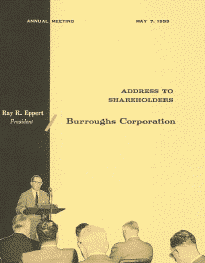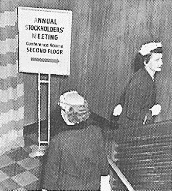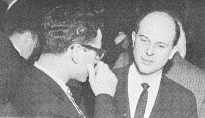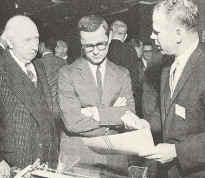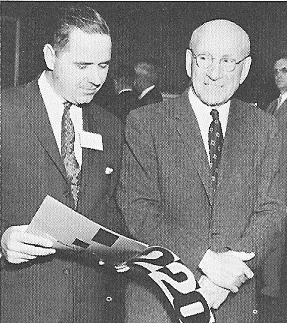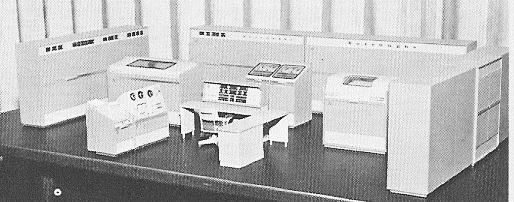|
Burroughs Address to Shareholders - 1959 |
||
|
Burroughs Corporation |
||
|
|
Remarks of President Ray R. Eppert at 74th annual meeting held in Detroit May 7, 1959 |
|
|
|
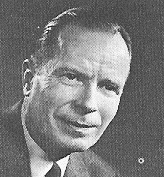
|
|
|
contents Resume of 1958, 2 |
||
|
ANNUAL MEETING
Since we convened a year ago, 4,800 stockholders have joined the many thousands of men and women who share ownership in Burroughs Corporation. Last week was Invest-In-America Week -- set aside to emphasize the importance of capital investment by men and women such as yourselves in the lifestream of American competitive enterprise. I think your presence here this morning, together with our expanding stockholder rolls, make an eloquent commentary on the continued vigor of democratic capitalism. Investment in America has been one touchstone of our country's greatness. .it is assuredly an even more important source of strength for the future.
Resume of 1958 The 12 months since our last meeting have been genuine milestones in your company's history. It was a year of challenge as well as accomplishment. The late recession caused a sharp curtailment of capital investments and a subsequent stretch-out in orders and deliveries. This business downturn confronted your company-as it did others -with falling rather than rising market demand. It placed a high premium on aggressive selling, operating austerity and prudent administering of finances. We feel that Burroughs not only weathered this test of economic adversity, but emerged from it the stronger because of the toughening discipline it imposed. Nineteen fifty-eight was distinguished by an increased tempo in the launching of our new product offensive. We brought forth during this 12 months the first fruits of a long-range development program in automation equipment, to broaden our revenue base and deepen our market penetration. With the introduction of these key products,
2 |
||
|
MAY, 1959
which I will later describe, we approached the major goal of welding our various machines into total integrated data processing systems. All of these advances along a widening product frontier are based on electronics-the coin of the future in the business machines industry. We have a task-force of top engineering and research specialists in our Paoli laboratories and in the company's various divisions, representing over 10% of our total personnel of 35,000. These engineers are the architects of our large commercial and military electronics programs. Management planning is polarized around research. around new product development, the lifeblood of any corporation. Through this research capability, your company is strategically placed in the mainstream of the new technology. I should like to make one final generalization about 1958 - namely, tthat we gained ground on a major objective which I defined here last year, the sharpening of our corporate image. While our product line had grown in diversity and sales increased 600 % in a single decade, the public conception of our business failed to keep up. Last year we initiated an institutional advertising and public |
||
|
ANNUAL MEETING
relations program to update our public personality and assume the correct identity of an aggressive corporation dedicated to the electronics age. The name "Burroughs"' for many decades has meant solid, dependable serviceand these virtues persist. They are now being joined in the public mind by the image of a powerful company whose products and know-how give it commanding leadership in the field of automation. Financial PictureDespite the recession, our total world-wide revenue in 1958 climbed to the all-time high of $294 million. This surpassed the previous year's record by over $10 million and represented a five-year increase in the revenue level of nearly $100 million. Entering 1959, the unfilled order backlog amounted to $220 million-an increase of 40 % over last year. This strong order position reflected the accelerated demand for our new electronic accounting and proof machines, and our 220 electronic computer systems. In addition, undelivered equipment on the SAGE, Atlas and electronic communications programs were prime causes for a considerable increase in our military product backlog. As you know, our net earnings for the year 1958 dipped rather sharply to $6,407,934. This was due to a complex of factors-principally the combined effect of our product development expenses and the general business recession. Accelerating our new product programs has, of course, involved heavy expenditures during a transition period when many of the incoming orders were concentrated on the newer but non-deliverable equipment.We did not permit the anticipated profit decline in 1958 to impede our planned program of facilities expansion. As you have noted in the annual report, our large Cumbernauld, Scotland plant was completed. Two new bank serv 4 |
||
|
MAY, 1959
ice plants were placed in operation in Malden, Massachusetts and Park Ridge, New Jersey. These facilities will volume-produce bank checks coded with magnetic ink. on which the entire bank automation program hinges. Other bank service plants will be activated this year, giving us unrivalled ability in the area of magnetic ink document preparation. What about 1959? As of March 31, world-wide income was $80,922,856 compared with $67,998,240 in the first quarter of 1958. Net income after taxes was $1,533,408 against $1,100,414Iast year. Incoming orders for commercial products were 25 % ahead of the same period in 1958. This profit improvement occurred in spite of abnormal engineering costs which were deliberately incurred in order to expedite certain automation and data processing developments. These equipments are now being demonstrated. More about this later. We expect the rising profit and volume trends indicated in the first quarter to continue in 1959.
Electronics
Our sales last year and during the first quarter of this year reflect certain programmed and evolutionary changes in the character of our business. The advent of the new technology has made this industry more competitive than ever before. Because electronics occupy center stage, we are deliberately permitting our electronic products to assert their dominance in percentage of total sales. We are consistently reinforcing the technical competence of our salesmen, to insure that they can compete effectively in the more sophisticated marketplace of electronics. During this period of strenuous product realignment, however, we have in no sense forsaken our traditional market in conventional machines. Without changing the bias of
5 |
||
|
ANNUAL MEETING
our development program, we have taken steps to keep functionally modern those mechanical and electro-mechanical products which fathered the corporation. Adding, calculating and accounting machines have been equipped with attachments, for instance, which make them compatible with the newer electronic systems.
Military Awards Our electronics program has been further stimulated by the receipt of prime government contracts involving precision computational and data processing equipment in numerous areas vital to the nation's security. The most glamorous such project is our guidance computing system for the Atlas intercontinental ballistic missile. In addition to many test shoots, the Burroughs computer was the electronic control which guided the Atlas satellite along a mathematical groove of space into orbit last winter. These complex systems were developed from Burroughs research and built at our Military Electronic Computer Division, together with giant data processors for the SAGE air defense network. Our total contract value in these two projects alone totals to date over $200 million. Overall, military products account for about 24 % of gross revenue. I want to emphasize that your management regards such military awards as a permanent phase of our business. Apart from our patriotic duty to serve defense needs, we consider military procurement and weapon systems work to be a stable and productive field quite compatible with our stated objectives. Yet, we have maintained a sensible balance between defense research and production contracts. We have not engaged in development contracts which have nowhere to go--like building a boat in a basement. And we have the further good fortune to be in a business whose
6 |
||
|
MAY. 1959 commercial projects and defense products require research in the same general area of techniques. Thus, both our regular business and the Defense establishment profit from these efforts. As products grow in complexity, field maintenance contracts for service to customers have increased. ..and represent an important sustaining source of income. Finally, our graphic systems business has shown growth, based on the proven capability of our Todd Division for producing checks, safety paper and other documents requiring considerable technical skill in layout and design. This phase of the business is accelerated, of course, by automation programs involving the use of magnetically encoded forms. The U. S. and Canadian market continues to be the largest single source of company revenue. Our International Division has spearheaded a successful drive to capture a larger share of foreign business. Burroughs overseas has been growing very rapidly, and in 1958 revenue from the International Division alone was one and one-quarter times the total Corporation of just 12 years ago.
Product Program I would like now to particularize my earlier references to our extensive new product program-our "pipeline to the future." I think the pipeline image is a good one. It emphasizes the basic concept which has shaped this entire campaign. In any period of rapid technological change manufacturers must at all costs guard against the obsolescence of their products by competitors. ..and against losing touch with the requirements of the marketplace. We are constantly dealing in competitive futures. ..demanding an accurate appraisal of tomorrow's customer needs 7
|
||
|
ANNUAL MEETING
and, most important, a planned program to have product answers ready when these needs come due. Without belaboring the metaphor, you can see the urgency of keeping our product pipelines full. At one end, we must have a continuing injection of research and development effort. ..at the other, a steady outpouring of new products and techniques. ..carefully synchronized, carefully phased-in with the developing needs of our customers. There is a time lag, of course, between input and output...particularly when we are changing the product mixture. Under favorable conditions, it typically requires at least four years to move a product from design and drawing-board stages to the production line.
Systems Approach As a footnote to this pipeline concept, our machines are being designed for assimilation in total data processing systems. From the small adding machine to the million dollar computer, each product fits organically as a building block in systems held together by common language magnetic tape, punch cards, punched paper tape, and the dramatic new magnetic encoded source document. They permit automation to be acquired progressively in any desired degree by any sized firm. Such systems involve an enormous amount of data input and output, of course. Thus, a prime target has been the perfection of those peripheral devices which feed in raw data and record the processed results. The competitive battle of data processing, it is clear, must be won on the periphery. ..we believe we have taken the lead on this frontier, offering a line of input-output gear whose scope and versatility surpasses anything in the industry. Let me quickly discuss some of these new products with
8 |
||
|
MAY, 1959
which we have seized the initiative in the automation race. I commented earlier on our conscious adaptation of military developments to commercial hardware. A clear example of such a dividend is the electronic teleprinter developed by Burroughs for the U. S. Signal Corps. Having been operated successfully at over 3,000 words per minute, this revolutionary device is the fastest page printer in communications history. It not only serves the government in high-speed transmission of weather reports, battle orders and other logistic data. ..but also can supply up-to-the-second message speed required by stock exchanges, telegraph offices, news gathering services, and so forth. Letters are shot at a racing roll of paper at one-millionth of a second by a bank of electrode guns. This becomes an ultimate printing technique, therefore, whose only limitation is the speed with which paper can be moved. (Incidentally, the maximum speed we have attained to date is 170 miles per hour.)
220 Computer System We are also producing a radically new all-transistorized line printer system used specifically with the Burroughs 220 electronic computer. It is the fastest such printer commercially available. Capable of printing up to 1500 lines of information per minute, this unit for the first time takes full advantage of the computer's internal speed in printing out results, On the input side, we equipped the 220 computer last year with the world's fastest photo reader. ..transmitting punched tape coded information to the computer's memory at the record speed of 1,000 characters per second. First deliveries on the 220 computer system were made in the last quarter of 1958 and are continuing at a satisfactory 9 |
||
|
ANNUAL MEETING
pace. This computer enjoys the same iron-clad reliability as our smaller 205 computing system.We introduced another computer last year, offering everyday businesses the advantages of the newer techniques on a low-cost basis. The F2000 computer, with its exclusive program selector, has found ready acceptance among businesses with repetitive problems, such as payroll and check preparation, billing, loan schedules, tax billing, etc.A new bank machine which prepares simultaneous and original printing on ledgers and statements was introduced just last month. This is our dual printer Sensimatic, permitting a single speedy posting operation with identical data printed on both sections of a combined form. Since less time is required to handle accounts, this machine gives banks much higher productivity and efficiency at a low level cost.We are currently at work on an initial contract awarded in 1958 by the U. S. Post Office for the production of ten automatic mail sorting machines, each of which will sort 36,000 pieces per hour to 300 destinations. Installations of these giant systems are scheduled for the last half of this year.
MICR Technology The heart of our new product offensive is the spectacular science called magnetic ink character recognition--MICR. You have all, I think, been exposed to our progress with this new technology through your dividend stuffer and our national advertising campaign. The slogan, "From checks to computers, there's a Burroughs MICR program for any system of automation you choose," sums up our unique capability in an area of major competitive importance. Your company traditionally has been the largest single
10 |
||
|
MAY, 1959
supplier of business machines to banks. ...We have asserted our leadership, therefore, in offering banks relief from the avalanche of paperwork involved in check and deposit accounting. The magnetic automation program will equally benefit commercial establishments. ..in billing, inventory control, sales analysis, insurance policy handling, accounting, data reduction, etc. But the initial impetus behind this effort pinpoints the important banking market.
11 |
||
|
ANNUAL MEETING
For the past four years Burroughs has devoted a tremendous amount of research and development work in collaboration with the American Bankers Association to develop a common language for magnetic ink character recognition. This is the famous E 13 B type font which you have seen in our advertising. ..the small numbers which are written in magnetic ink at the bottom of the check to identify the bank number, your account number and the amount. Because they are readable by automatic sorters and other equipment, these tiny numbers have revolutionized the historic function of the check and other documents. Where once the check was used merely to transfer funds from one account to another, it soon will become the chief vehicle for transmitting all the vital information required throughout an entire banking or accounting system. Because the MICR printing tolerances are extremely fine, proper document control at the source is vital. Through our Todd Division, with its long history of precision check production and supply, we are able to volume-produce magnetically inscribed coded documents guaranteed to meet the rigid specifications set down by the ABA. Your company is fortunate in being the industry's only triple threat in the MICR program. ..major equipment manufacturer, major document supplier and major systems specialist. ... We have organized a battery of automation products which we consider exclusive from both a competitive and customer service point of view. We begin with our new Imprinter---designed for precise on-premises encoding of magnetic ink characters by the bank itself. Larger orders for checks can be handled by our Todd printing plants. Next we have our MICR Amount and Account Number Printer for on-the-spot automatic proving of encoded documents after they have made their
12
|
||
|
MAY, 1959
way through public hands and back to the banks. Following this is the MICR Proof and Distribution System, also with magnetic amount printer, of principal importance in automating the proof and distribution of "over the counter" deposits and the transit operation between banks.The most dramatic component in the system is the world's fastest document sorter, currently on display and arousing enthusiastic response. It reads magnetic ink data on checks, deposit slips and other documents, and sorts the items at the rate of 1560 a minute. It can handle mixed paper and card stock documents of various sizes and various degrees of wear and mutilation. Finally, its output can be connected to a forthcoming multi-lister when an electronic computer is to be used as a processing unit in the system. In just one pass, the documents at full sorter speed---1500 items per minute---can be listed, totaled, and the account identification and money factors converted to magnetic tape for computer input. Thus, editing, sorting, proving and conversion to magnetic tape is accomplished in a single, automatic, high-speed operation.
As you can see, this automation program involves products from all divisions of our company.
Competitive Position The competitive implications of our automation programs, of course, are tremendous, and the demands for greater productivity are becoming more urgent. In the United States, in spite of our great population growth, the Gross National Product must and will expand at a very much faster rate than the labor force available to produce this higher economic activity.
13 |
||
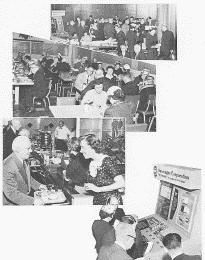
14 |
||
|
MAY, 1959
Greater automation is essential if we are to achieve the productivity goals which will assure a continued rise in our standard of living and the maintenance of a competitive position for America's products in world markets. Your company is in the most dynamic sector of this field--office automation. Today more people are involved in data processing in offices than are employed in all manufacturing in the United States. The equipments produced by your company and the business machines industry will find a market of explosive proportions as the years go by. This much is certain: the key to adequate earnings lies in our ability to bring useful products to a demanding market. As I have described at some length, Burroughs has molded a powerful, thoroughly tested product line for exploiting the automation market. ..in which every machine can qualify as componentry for integrated data processing systems. These factors are not easy to translate statistically on an exact timetable. But coupled with our overall capability in deliverable hardware and production facilities, we are confident that your company is entering a period of strong competitive advance. In closing may I express our thanks to all of Burroughs world-wide employees for their loyal and vigorous efforts in meeting today's problems. To you, the growing family of Burroughs shareholders, go our sincere thanks for the confidence and support you have so generously given us in management. Thank you.
15
|
||
|
ANNUAL MEETING
Stockholders elected the following ten Directors of the Corporation: Harold S. Chase, Walker L. Cisler, Ray R. Eppert, Thomas G. Long, Ray W. Macdonald, Charles H. Percy, Charles Sawyer, Kenneth C. Tiffany, George L. Todd, and Irven Travis.Stockholders also approved an increase in authorized capital stock from 7,500,000 shares, with a par value of $5 per share, to 8,500,000 shares, and amendment of the Articles of Association to this effect. The vote was 5,373,197 shares for, and 58,403 shares against. * * * * *
Following the meeting, the Board of Directors appointed two new vice presidents of the Corporation. FRANK G. ARMSTRONG, director of industrial relations, was named vice president--industrial relations. JAMES F. LILLIS, controller, was appointed vice president and controller. Armstrong joined Burroughs in 1946 as supervisor of personnel relations, was named assistant director of industrial relations in 1953 and director in 1957. A graduate of the University of Michigan in 1935, he received a law degree from the Detroit College of Law in 1946. Lillis joined Burroughs as assistant controller in 1949, and was promoted to controller in 1951. For several years previously, he served on the staff of Price Waterhouse & Co., certified public accountants. He received a degree in business administration from New York University.
16
|
||
| We are actively
seeking information related to any of the topics presented on this
page... please email info@smecc.org if
you can be of assistance!
Thanks, Ed Sharpe archivist for SMECC |
||
